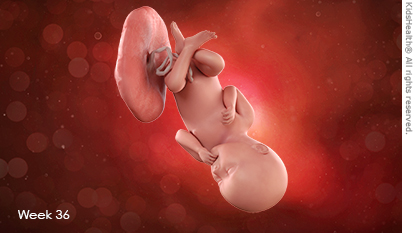- Home
- Humana Medicaid
- Kentucky Medicaid
- Medicaid extras
- Health and wellness
- Parents Home
- Para Padres
- A to Z Dictionary
- Allergy Center
- Asthma
- Cancer
- Diabetes
- Diseases & Conditions
- Doctors & Hospitals
- Emotions & Behavior
- First Aid & Safety
- Flu (Influenza)
- Food Allergies
- General Health
- Growth & Development
- Heart Health & Conditions
- Homework Help Center
- Infections
- Newborn Care
- Nutrition & Fitness
- Play & Learn
- Pregnancy Center
- Preventing Premature Birth
- Q&A
- School & Family Life
- Sports Medicine
- Teens Home
- Para Adolescentes
- Asthma
- Be Your Best Self
- Body & Skin Care
- Cancer
- Diabetes
- Diseases & Conditions
- Drugs & Alcohol
- Flu (Influenza)
- Homework Help
- Infections
- Managing Your Weight
- Medical Care 101
- Mental Health
- Nutrition & Fitness
- Q&A
- Safety & First Aid
- School, Jobs, & Friends
- Sexual Health
- Sports Medicine
- Stress & Coping
Pregnancy Calendar: Week 36
Your Baby's Development
The tiny wrinkly fetus you saw on earlier ultrasounds is fast becoming a plump baby. Fat on the cheeks and powerful sucking muscles contribute to your baby's fuller face. Your baby now weighs a little under 6 pounds (2,721 grams).
The bones that make up your baby's skull can move and overlap each other. This is called molding, and it helps the baby pass through the birth canal. Don't be surprised if your little one arrives with a pointy or misshapen head! After a few hours or days, your baby's head will be back to a rounded shape.

Your Body
 You now might see your health care provider every week. Your doctor or midwife may do an internal exam to see if cervical effacement (thinning of the cervix) or dilation (opening of the cervix) has begun. The baby might drop into your pelvis in preparation for labor — this is called engagement or lightening. Your appetite may return because the baby isn't putting as much pressure on your stomach and intestines, and if you've had heartburn, that might ease.
You now might see your health care provider every week. Your doctor or midwife may do an internal exam to see if cervical effacement (thinning of the cervix) or dilation (opening of the cervix) has begun. The baby might drop into your pelvis in preparation for labor — this is called engagement or lightening. Your appetite may return because the baby isn't putting as much pressure on your stomach and intestines, and if you've had heartburn, that might ease.

© 1995- The Nemours Foundation. KidsHealth® is a registered trademark of The Nemours Foundation. All rights reserved.
Images sourced by The Nemours Foundation and Getty Images.
